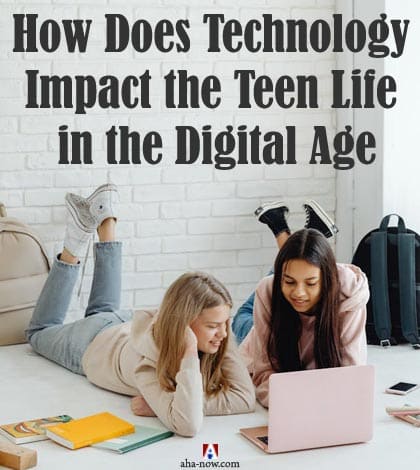How Does Technology Impact the Teen Life in the Digital Age
As an adult, do you notice a stark difference between the life of teens today and when you were a teen? Here's a review of the teen life in the digital age.

Teens today do things differently. This is because of the technological developments that have introduced new options of entertainment, interaction, and socializing. Like everything else, these have their pros and cons. Here’s an overview of how the teen life has changed in the digital age. ~ Ed.

The digital age has changed everything, especially for teens whose relationship with entertainment has been completely flipped on its head. From smartphones and streaming to gaming and social media, teens are more plugged in than ever. This has changed how they consume content, interact with each other, and express themselves.
While technology in entertainment offers more access and opportunities than ever, it also presents challenges like screen time management, online safety, and balancing virtual life with real life. In this post, we’ll look at how technology has changed entertainment for teens, the benefits and the drawbacks.
11 Ways Technology Has Impacted the Life of Teens
Do teens nowadays watch TV, hangout in the neighborhoods, or listen to the radio? Mostly, no. This is because the teens have access to new options as a result of technological developments.
Entertainment for Teens
Entertainment for teens has changed a lot over the years. A few decades ago teens used TV, movies, and music for leisure and consumed it through traditional means like broadcast TV or physical CDs. Today technology has turned entertainment into a dynamic, interactive, and personal experience. Smartphones, tablets, and laptops are the primary tools for entertainment and streaming services, gaming apps and social media platforms are at their fingertips.
With this change, teens are no longer passive consumers of entertainment. They are active participants curating their content and interacting with creators through likes, shares, and comments. This has allowed them to experience entertainment in ways previous generations could only have dreamed of.
Streaming Services: Changing Content Consumption
One of the biggest changes in modern entertainment for teens is the rise of streaming services. Platforms like Netflix, Hulu, and Disney+ have replaced traditional TV for many teens, offering an endless library of content they can watch anytime, anywhere. The ability to binge-watch entire series or choose from thousands of movies has made entertainment more flexible, allowing teens to decide what, when, and how they consume content.
Streaming services have also given teens the ability to explore different genres and global content that was hard to access before. This has widened their entertainment horizons and exposed them to new cultures, ideas, and perspectives. However, the convenience of streaming has also raised concerns about screen time and its impact on mental and physical health.
Social Media: The New Frontier
Social media platforms like Instagram, TikTok, and YouTube are at the heart of teen entertainment in the digital age. These platforms give teens a space to hang out with friends, discover new trends, and share their content. Short-form videos on TikTok in particular have captured the teen demographic, offering quick, fun content that’s relatable or funny.
Social media has also turned teens into content creators themselves. With a smartphone, teens can film, edit, and post videos, show off their talents, or share their opinions on the latest trends. This has democratized entertainment, giving every teen a platform and a voice. But the pressure to get likes, followers, and approval from peers can lead to self-esteem and online safety issues.
Gaming: Interactive Entertainment
Gaming has become one of the most popular forms of entertainment for teens in the digital age. Platforms like PlayStation, Xbox, and PC gaming have moved from simple single-player experiences to complex multiplayer environments where teens can hang out with friends or compete with players around the world. Games like Fortnite, Minecraft, and Call of Duty have become cultural phenomena with millions of teens playing daily.
The interactivity of gaming has made it more than just a passive form of entertainment. For many teens, it’s a way to socialize, problem-solve, and develop strategic thinking. Gaming is a form of escapism, providing an immersive experience that engages the mind and emotions. But like other forms of digital entertainment, excessive gaming can raise concerns about addiction and its impact on academic performance and physical health.
Music and the Digital Revolution
The way teens discover and listen to music has changed dramatically in the digital age. Music streaming services like Spotify, Apple Music, and YouTube have given teens instant access to millions of songs from around the world. Teens can create their playlists, follow their favorite artists, and discover new music through algorithm-generated recommendations.
Social media has also had a big impact on teen music trends, with platforms launching unknown artists to stardom overnight. Viral dance challenges and music trends spread quickly among teens, shaping their tastes and how they consume music. While the digital revolution has made music more accessible, it’s also changed how teens value and engage with music, often leading to shorter attention spans when discovering new artists.
Mobile Devices and Teen Entertainment
Mobile devices are at the heart of teen entertainment. Smartphones and tablets are the go-to tools for teens to access social media, gaming apps, streaming services, and music platforms. These devices are not just for communication – they’re entertainment hubs that allow teens to connect with friends, consume content, and engage with the digital world at any time.
The portability of mobile devices has made entertainment more accessible than ever, teens can watch a movie, play a game, or chat with friends from almost anywhere. But this constant connectivity can lead to overstimulation and an unhealthy reliance on technology for entertainment. Managing screen time and encouraging offline activities are key to a balanced lifestyle.
Technology and Social Interactions
While technology has given teens access to a vast array of entertainment options, it’s also impacted their social interactions. Many teens now socialize through online platforms and gaming rather than face-to-face interactions. This can be good and bad – on one hand, it allows teens to connect with peers around the world, but on the other, it can lead to isolation and decreased interpersonal communication skills.
The challenge for teens is finding a balance between online and offline socialization. While technology offers entertainment and connection, teens need to maintain real-life relationships and engage in activities that promote social development.
Creative Outlets in the Digital Age
Technology has also given teens new creative outlets for self-expression. From editing videos on TikTok to building virtual worlds in games like Minecraft, teens are finding new ways to express themselves. Digital art, photography, and content creation are accessible to anyone with a smartphone or computer, giving teens the tools to produce professional quality content.
This digital creativity has opened up new opportunities, many teens are getting recognition and even earning money through platforms like YouTube and Instagram. However, the pressure to perform and the need for social media validation can sometimes overshadow the joy of creating.
Managing Screen Time
One of the biggest challenges of the digital entertainment era is managing screen time. With so many options available it’s easy for teens to spend hours gaming, streaming or social media-ing without even realizing how much time has passed. Excessive screen time can lead to eye strain, sleep problems, and reduced physical activity.
Parents and teens need to find a balance between screen time and other activities like outdoor play, hobbies, and face-to-face social interactions. Setting limits on device usage and taking breaks can help teens have a healthier relationship with technology.
Solitaire and the Return of Simple Games
While technology has given us complex and immersive entertainment options, some teens still enjoy simple, nostalgic games. Solitaire is a popular choice for teens looking for a quick, low-pressure game that doesn’t require the internet or social interaction.
It’s a reminder that not all digital entertainment has to be flashy or competitive – sometimes a simple game like solitaire is the perfect moment of calm. This return to simple games shows that technology can offer a range of experiences from highly interactive to quietly meditative to suit different moods and tastes.
Online Safety and Privacy
As teens spend more time online for entertainment, online safety and privacy become a bigger issue. Social media platforms, gaming environments, and even streaming services can expose teens to risks like cyberbullying, identity theft, and inappropriate content.
Educating teens about online safety, privacy settings, and responsible digital behavior is key to protecting them in the digital entertainment landscape. Parents can help by talking to teens about online safety, setting parental controls, and monitoring usage to create a safe space for teens to use technology responsibly.
Wrapping Up
In conclusion, technology has changed the way teens experience entertainment, it’s full of opportunities for engagement, creativity, and connection. While that’s great, it also brings challenges, especially in managing screen time and online safety. By balancing the digital and real world teens can navigate the modern entertainment landscape well.
Over to you
Are you a parent to a teen child? Have observed any changes in teen life these days? What are your thoughts on the impact of technological developments on the young generation? Share your thoughts and comments in the comments section.
Disclaimer: Though the views expressed are of the author’s own, this article has been checked for its authenticity of information and resource links provided for a better and deeper understanding of the subject matter. However, you're suggested to make your diligent research and consult subject experts to decide what is best for you. If you spot any factual errors, spelling, or grammatical mistakes in the article, please report at [email protected]. Thanks.

 Fransebas
Fransebas 































